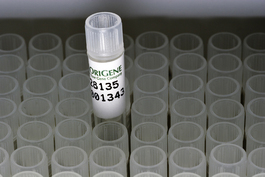Melanopsin (OPN4) (NM_001030015) Human Untagged Clone
CAT#: SC302494
OPN4 (untagged)-Human opsin 4 (OPN4), transcript variant 2
"NM_001030015" in other vectors (4)
Product Images

Specifications
| Product Data | |
| Type | Human Untagged Clone |
| Tag | Tag Free |
| Symbol | OPN4 |
| Synonyms | MOP |
| Vector | pCMV6-Entry |
| E. coli Selection | Kanamycin (25 ug/mL) |
| Mammalian Cell Selection | Neomycin |
| Sequence Data |
>NCBI ORF sequence for NM_001030015, the custom clone sequence may differ by one or more nucleotides
ATGAACCCTCCTTCGGGGCCAAGAGTCCCGCCCAGCCCAACCCAAGAGCCCAGCTGCATGGCCACCCCAG CACCACCCAGCTGGTGGGACAGCTCCCAGAGCAGCATCTCCAGCCTGGGCCGGCTTCCATCCATCAGTCC CACAGCACCTGGGACTTGGGCTGCTGCCTGGGTCCCCCTCCCCACGGTTGATGTTCCAGACCATGCCCAC TATACCCTGGGCACAGTGATCTTGCTGGTGGGACTCACGGGGATGCTGGGCAACCTGACGGTCATCTATA CCTTCTGCAGAGCTGTGCTTCGTGGAGTCACTGTGATGATGCAGAGCAGAAGCCTCCGGACACCTGCCAA CATGTTCATTATCAACCTCGCGGTCAGCGACTTCCTCATGTCCTTCACCCAGGCCCCTGTCTTCTTCACC AGTAGCCTCTATAAGCAGTGGCTCTTTGGGGAGACAGGCTGCGAGTTCTATGCCTTCTGTGGAGCTCTCT TTGGCATTTCCTCCATGATCACCCTGACGGCCATCGCCCTGGACCGCTACCTGGTAATCACACGCCCGCT GGCCACCTTTGGTGTGGCGTCCAAGAGGCGTGCGGCATTTGTCCTGCTGGGCGTTTGGCTCTATGCCCTG GCCTGGAGTCTGCCACCCTTCTTCGGCTGGAGCGCCTACGTGCCCGAGGGGTTGCTGACATCCTGCTCCT GGGACTACATGAGCTTCACGCCGGCCGTGCGTGCCTACACCATGCTTCTCTGCTGCTTCGTGTTCTTCCT CCCTCTGCTTATCATCATCTACTGCTACATCTTCATCTTCAGGGCCATCCGGGAGACAGGACGGGCTCTC CAGACCTTCGGGGCCTGCAAGGGCAATGGCGAGTCCCTGTGGCAGCGGCAGCGGCTGCAGAGCGAGTGCA AGATGGCCAAGATCATGCTGCTGGTCATCCTCCTCTTCGTGCTCTCCTGGGCTCCCTATTCCGCTGTGGC CCTGGTGGCCTTTGCTGGGTACGCACACGTCCTGACACCCTACATGAGCTCGGTGCCAGCCGTCATCGCC AAGGCCTCTGCAATCCACAACCCCATCATTTACGCCATCACCCACCCCAAGTACAGGGTGGCCATTGCCC AGCACCTGCCCTGCCTGGGGGTGCTGCTGGGTGTATCACGCCGGCACAGTCGCCCCTACCCCAGCTACCG CTCCACCCACCGCTCCACGCTGACCAGCCACACCTCCAACCTCAGCTGGATCTCCATACGGAGGCGCCAG GAGTCCCTGGGCTCGGAGAGTGAGGTGGGCTGGACACACATGGAGGCAGCAGCTGTGTGGGGAGCTGCCC AGCAAGCAAATGGGCGGTCCCTCTACGGTCAGGGTCTGGAGGACTTGGAAGCCAAGGCACCCCCCAGACC CCAGGGACACGAAGCAGAGACTCCAGGGAAGACCAAGGGGCTGATCCCCAGCCAGGACCCCAGGATGTAG |
| Restriction Sites | SgfI-MluI |
| ACCN | NM_001030015 |
| OTI Disclaimer | Our molecular clone sequence data has been matched to the reference identifier above as a point of reference. Note that the complete sequence of our molecular clones may differ from the sequence published for this corresponding reference, e.g., by representing an alternative RNA splicing form or single nucleotide polymorphism (SNP). |
| OTI Annotation | This TrueClone is provided through our Custom Cloning Process that includes sub-cloning into OriGene's pCMV6 vector and full sequencing to provide a non-variant match to the expected reference without frameshifts, and is delivered as lyophilized plasmid DNA. |
| Product Components | The cDNA clone is shipped in a 2-D bar-coded Matrix tube as dried plasmid DNA. The package also includes 100 pmols of both the corresponding 5' and 3' vector primers in separate vials. Every lot of primer is tested to provide clean sequencing of OriGene TrueClones. |
| Reconstitution | 1. Centrifuge at 5,000xg for 5min. 2. Carefully open the tube and add 100ul of sterile water to dissolve the DNA. 3. Close the tube and incubate for 10 minutes at room temperature. 4. Briefly vortex the tube and then do a quick spin (less than 5000xg) to concentrate the liquid at the bottom. 5. Store the suspended plasmid at -20°C. The DNA is stable for at least one year from date of shipping when stored at -20°C. |
| Reference Data | |
| RefSeq | NM_001030015.2, NP_001025186.1 |
| RefSeq Size | 2419 bp |
| RefSeq ORF | 1470 bp |
| Locus ID | 94233 |
| Cytogenetics | 10q23.2 |
| Protein Families | Druggable Genome, Transmembrane |
| Gene Summary | Opsins are members of the guanine nucleotide-binding protein (G protein)-coupled receptor superfamily. This gene encodes a photoreceptive opsin protein that is expressed within the ganglion and amacrine cell layers of the retina. In mouse, retinal ganglion cell axons expressing this gene projected to the suprachiasmatic nucleus and other brain nuclei involved in circadian photoentrainment. In mouse, this protein is coupled to a transient receptor potential (TRP) ion channel through a G protein signaling pathway and produces a physiologic light response via membrane depolarization and increased intracellular calcium. The protein functions as a sensory photopigment and may also have photoisomerase activity. Experiments with knockout mice indicate that this gene attenuates, but does not abolish, photoentrainment. Alternative splicing results in multiple transcript variants encoding different isoforms. [provided by RefSeq, Jul 2008] Transcript Variant: This variant (2) includes an alternate in-frame exon in the 5' coding region, compared to variant 1, resulting in a longer protein (isoform 2) compared to isoform 1. |
Documents
| Product Manuals |
| FAQs |
Resources
Other Versions
| SKU | Description | Size | Price |
|---|---|---|---|
| RC215793 | OPN4 (Myc-DDK-tagged)-Human opsin 4 (OPN4), transcript variant 2 |
USD 420.00 |
|
| RG215793 | OPN4 (GFP-tagged) - Human opsin 4 (OPN4), transcript variant 2 |
USD 460.00 |
|
| RC215793L3 | Lenti-ORF clone of OPN4 (Myc-DDK-tagged)-Human opsin 4 (OPN4), transcript variant 2 |
USD 620.00 |
|
| RC215793L4 | Lenti-ORF clone of OPN4 (mGFP-tagged)-Human opsin 4 (OPN4), transcript variant 2 |
USD 620.00 |
{0} Product Review(s)
Be the first one to submit a review






























































































































































































































































 Germany
Germany
 Japan
Japan
 United Kingdom
United Kingdom
 China
China
